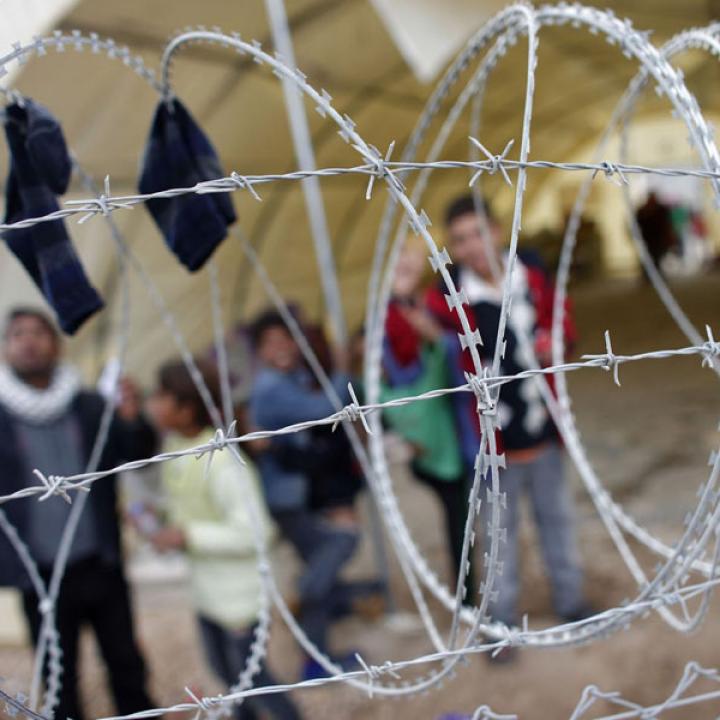
- Policy Analysis
- Fikra Forum
Response to “Al-Hawl Camp: A Potential Incubator of the Next Generation of Extremism”

Himbervan Kose, in his article “Al-Hawl Camp: A Potential Incubator of the Next Generation of Extremism” provides an apt description of the problem of radicalization at the al-Hawl camp of ISIS fighters and their families in Northeastern Syria along with several debatable pointers on how to address the issue. It is crucial, however, to underline that the current predicament faced by the Northeast Syrian Autonomous Region in al-Hawl is likely a deliberate part of ISIS’s strategy of tactical defeat rather than an incidental byproduct of warfare. Understanding this strategy should inform future steps at the camp to avoid falling into the trap of enabling future ISIS propaganda surrounding the camp.
Although ISIS’s narrative to its worldwide audience emphasized the belief that the emergence of the “Islamic State” was a feature of a divine mandate with apocalyptic dimensions, the actions of ISIS indicate that they were cognizant of the ultimately untenable nature of their predatory model of territorial expansion.
Even during the process of its defeat, ISIS worked to select its own enemies and to define the nature of the battles and left its foes with “bitter victories”―rubble, refugees, and high drain on resources. ISIS’s narrative to its loyal core even before the defeat highlighted the need to demonstrate unshakable will, heroism, fidelity, and a commitment to raising the next generation to become followers of ISIS. To further strengthen this propaganda effect, ISIS allowed the highly unusual filming of (fully covered) women in some of its propaganda releases in its “epic” last stand at Baghuz, which it classified as a “test of the believers” (ibtila’). The subsequent imprisonment of these families—mainly at al-Hawl—is now framed by ISIS as one of triumph over adversity, with the enemy having been divinely manipulated to enable the future rebirth of an ISIS army.
Given this propaganda, and while in no way diminishing the accomplishments and the sacrifice of the Syrian Democratic Forces (SDF), it is important to stress that ISIS actually preferred for this group—led by the Kurdish People’s Protection Units (YPG)—to be its ultimate victor. Defeat at the hands of the SDF has played into the ISIS narrative due to the expectation that the SDF’s Western support will bind it to international standards towards captives that ISIS can exploit, and because the YPG’s ideology and values are denigrated as anathema to ISIS’s version of Islam. Both factors are likely to help solidify the cohesion of ISIS fighters and their families within the camps.
By abandoning the non-combatant ISIS population to the camps in PYD-ruled Northeast Syria, the international community is helping to reinforce the above narrative in ways that may ultimately benefit a resurgence of ISIS. Meanwhile, it is hard to see how any court that is set up in Northern Syria, in the manner that Kose suggests, would be able to diffuse the situation. Instead, efforts at dispensing justice inside Northern Syria are likely to provide further material for recruitment and propaganda through the mischaracterization of any and all court procedures.
Instead, camp al-Hawl must be closed if ISIS is to be denied the future army it sees fomenting in the camp. The best course of action may be to establish a global fund to supervise and finance the repatriation of all the camp’s population to their countries of origin, as mandated by international law. Funding should then be allocated for customized programs of de-radicalization and re-integration, developed locally and managed globally. The interned population of Camp al-Hawl, which should be understood as a potential ISIS army in the making, cannot be left concentrated and allowed to incubate. Instead, reducing this group to its national components is the best way to handle a potentially explosive situation.
Radicalization in the al-Hawl camp demonstrates that the war with ISIS is far from over. Abandoning the fight now is tantamount to offering ISIS a victory that will cost the world community far more in blood and resources than is currently needed to properly address the issue today.
UPDATE: By announcing the removal of its outposts in Northeastern Syrian, the Trump Administration has decided to enable a confrontation between its allies. For ISIS, this is indeed welcome news. The Turkish operation against the PYD-led region of northeastern Syria presents a multitude of opportunities for the terror organization to benefit, the most ominous of which being the one inadvertently offered by President Trump himself. The U.S. president has declared that captive ISIS fighters will become the responsibility of Turkey upon the establishment of its putative safe zone in Northeastern Syria.
Ankara, which has a demonstrable record of leveraging ISIS against the PKK-aligned PYD, cannot be entrusted with the management of the vexing problem of ISIS’s legacy of fighters and families. Turkey is openly seeking to deny the PYD the ability to create or maintain its autonomous region by reducing it geographically and reconfiguring it demographically through the anticipated relocation of Syrian refugees. Such conditions may provide ISIS with the reasonable prospect of emulating in the new Turkish supervised zone what the terrorist organization Jabhat al-Nusrah has accomplished in Idlib province under Turkish supervision―that of an underground spoiler when opposition is vigorous, and an open bully when it is weak. The United States’ abdication of position in the Syrian theaters will likely prove to be a mistake. But if Washington hopes to prevent the situation from devolving into an unmitigated disaster, the administration should certainly insure that the human legacy of ISIS in the al-Hawl camp remains firmly under its supervision.


